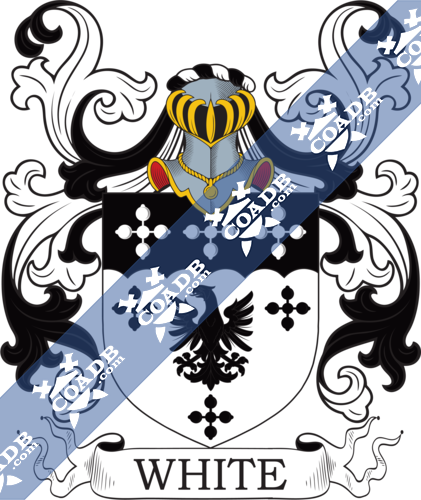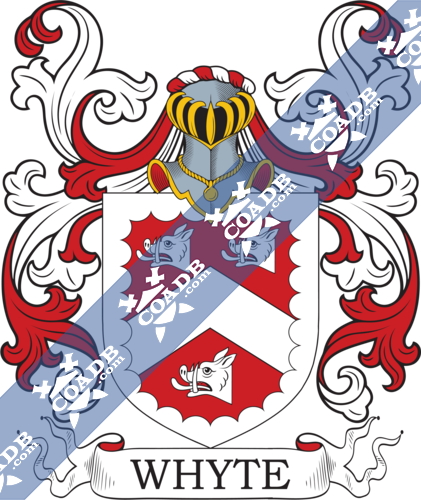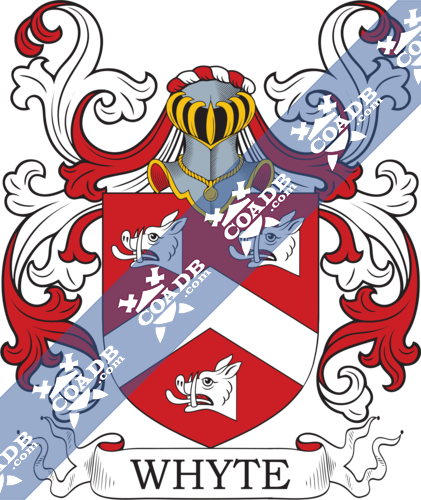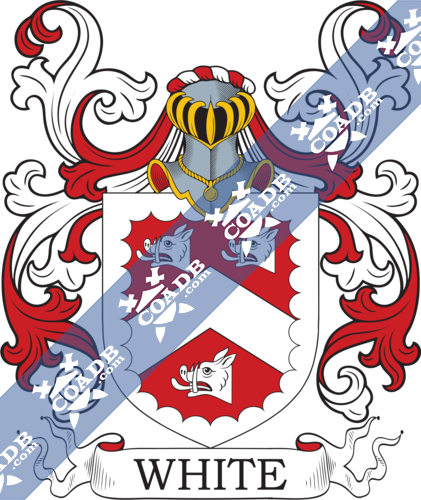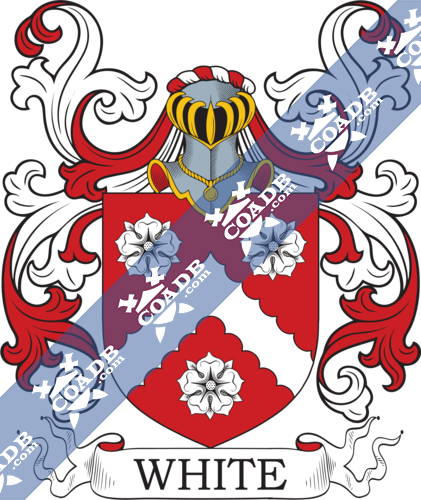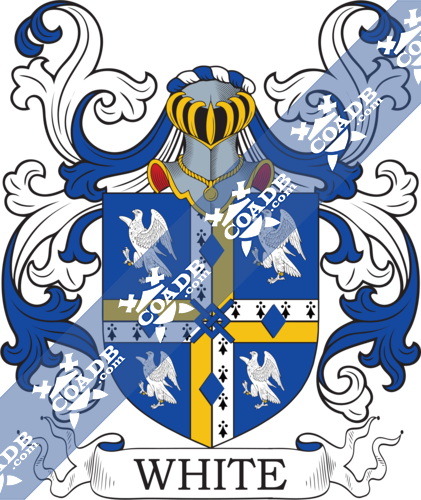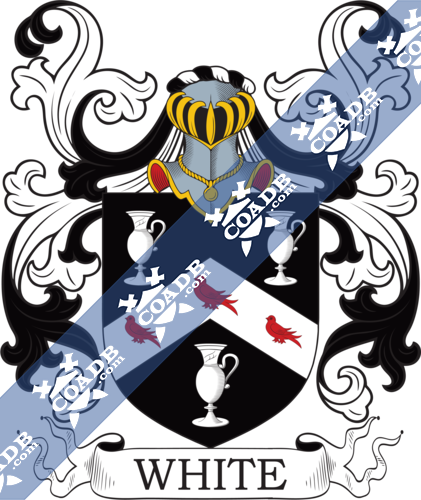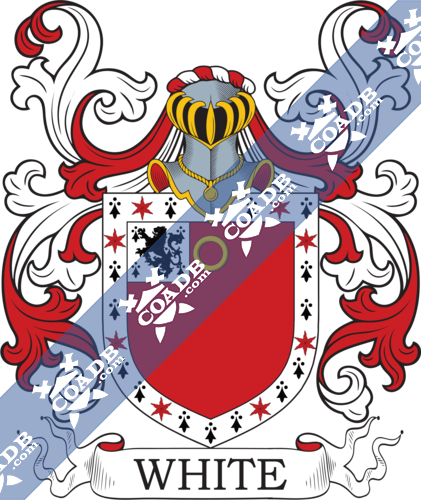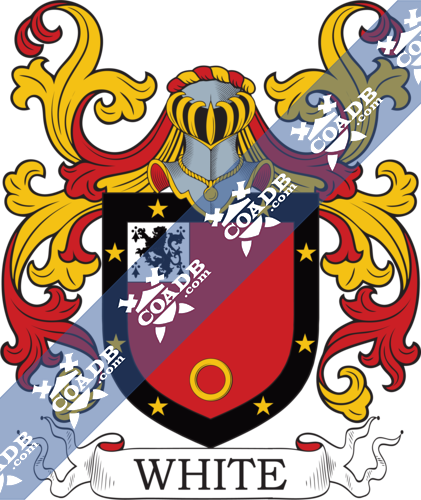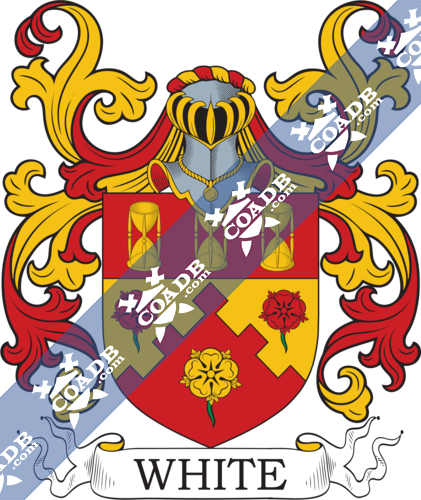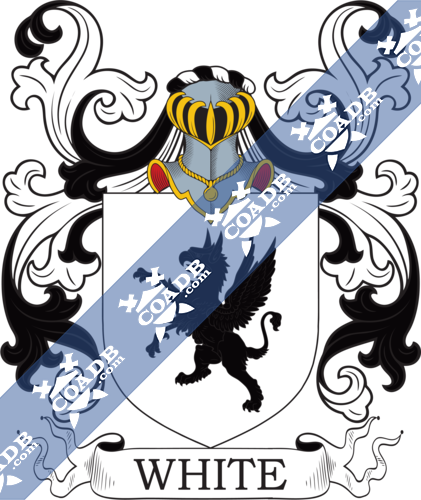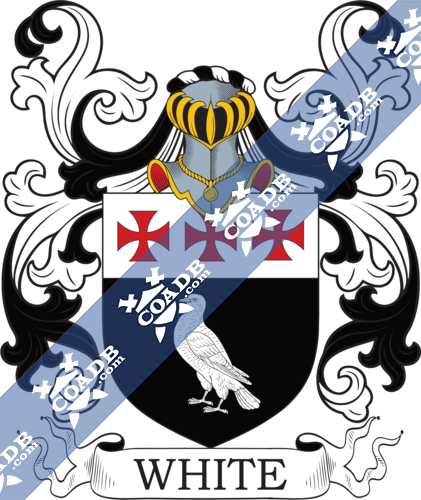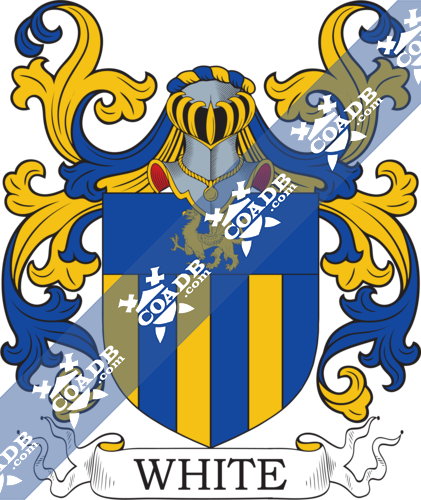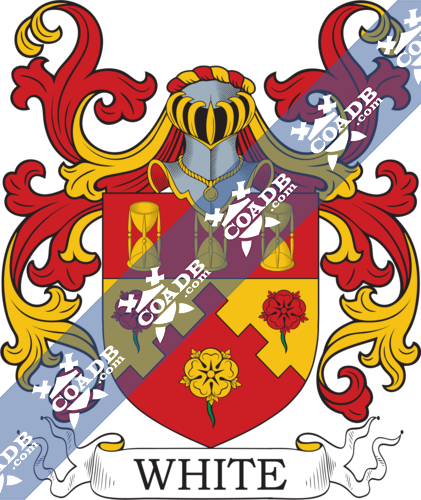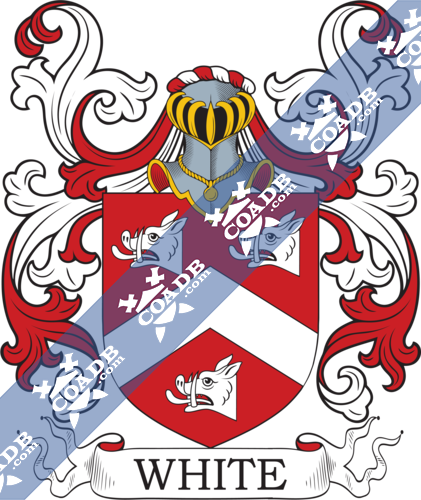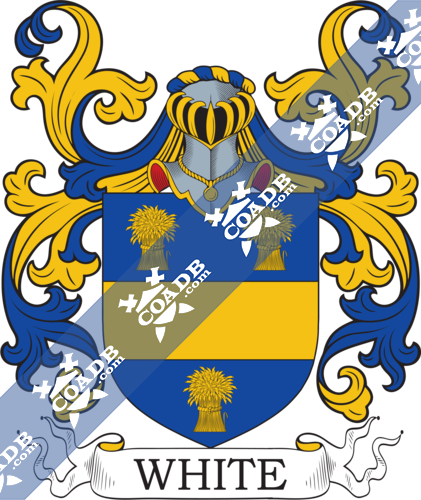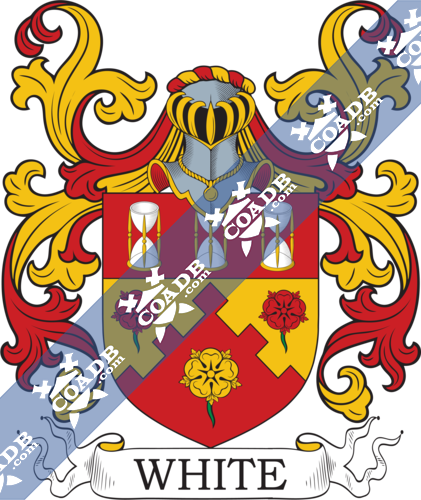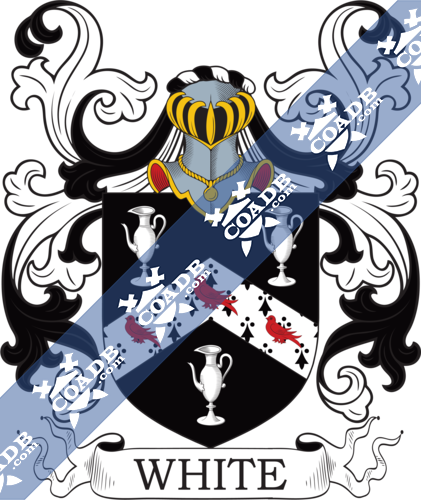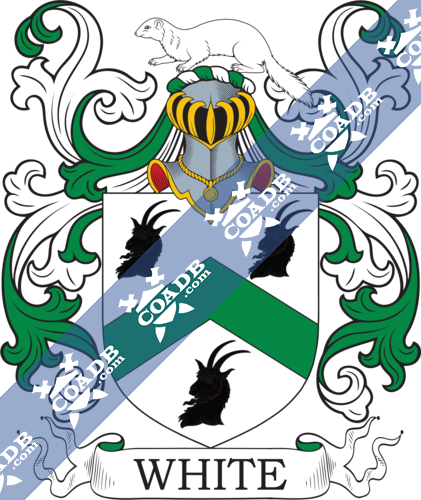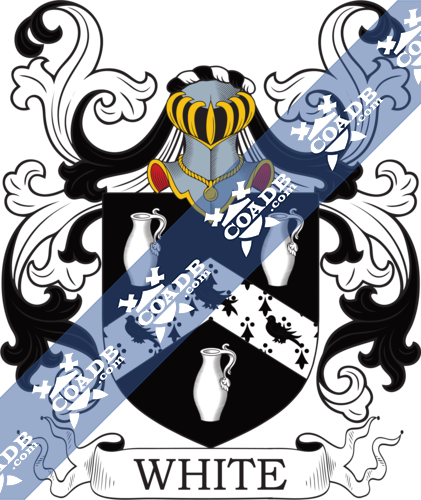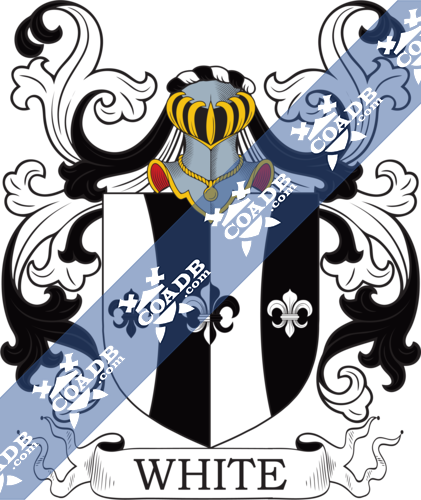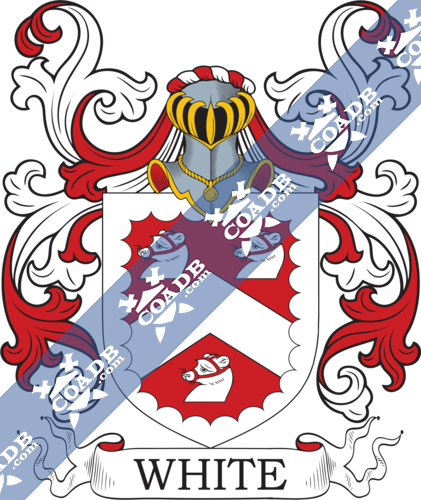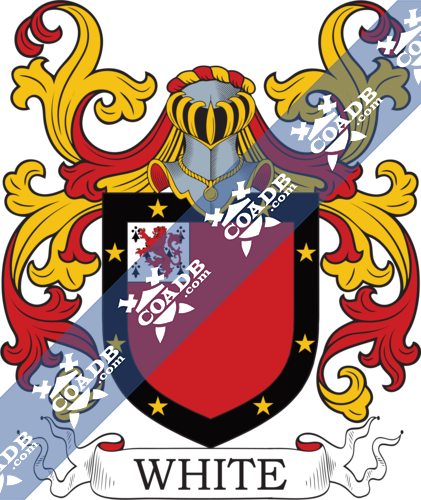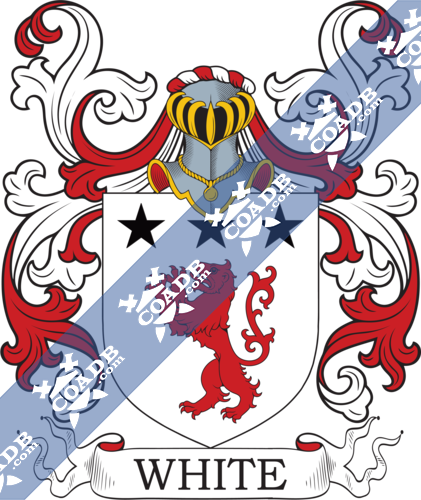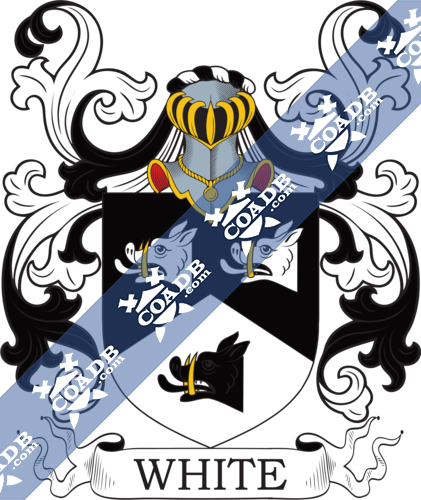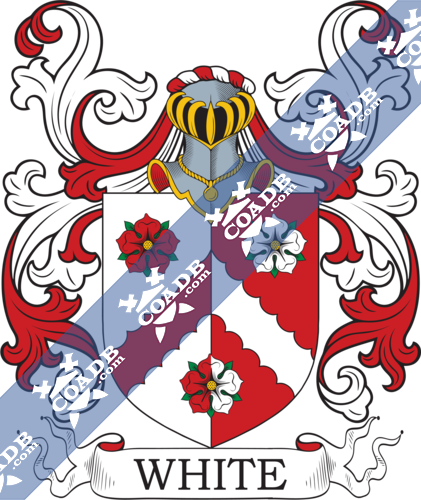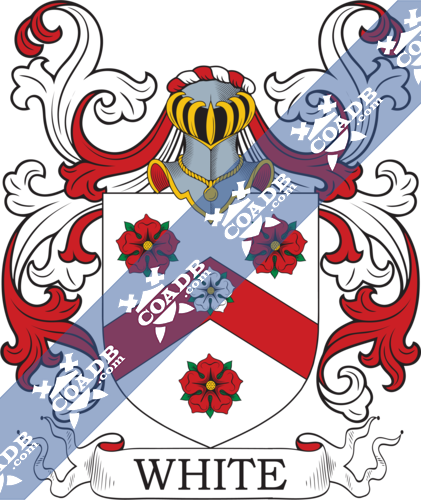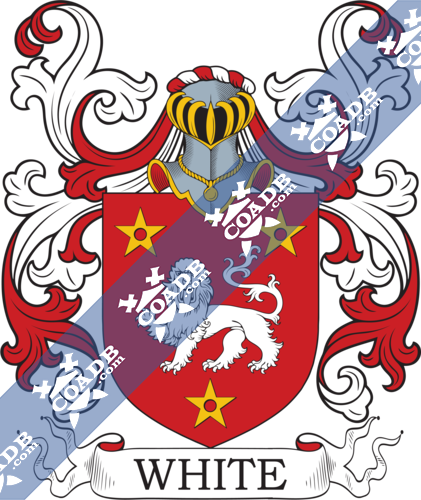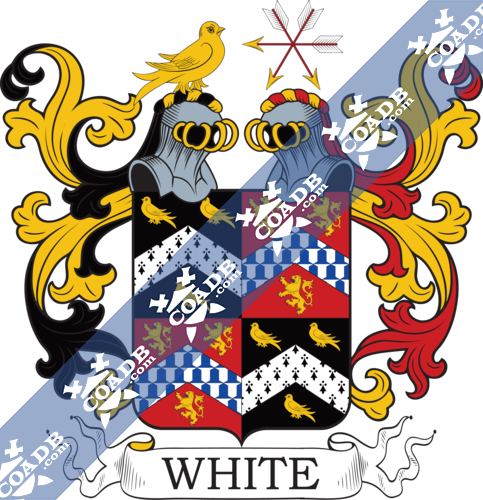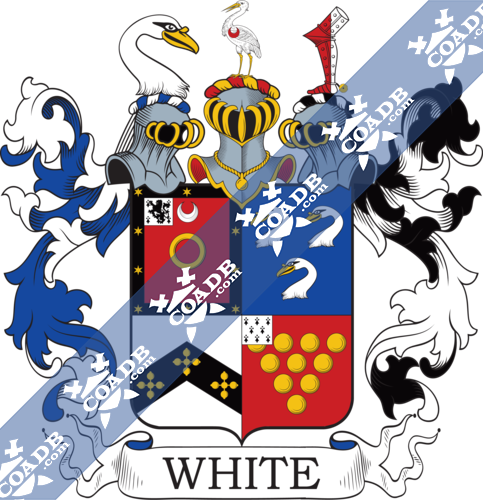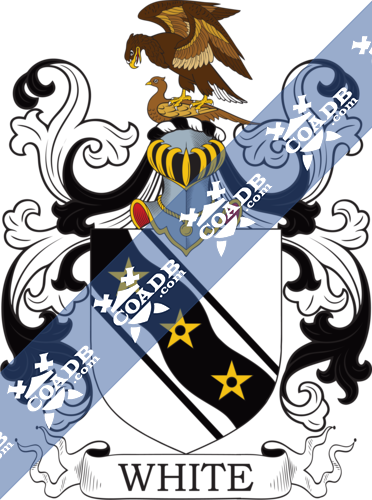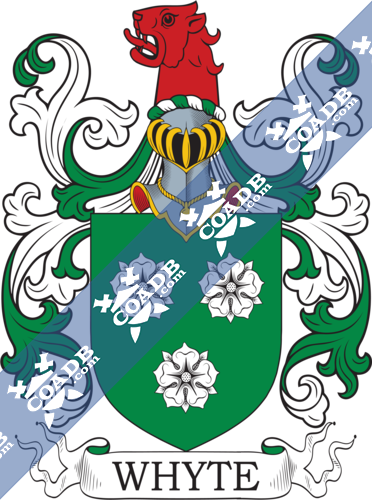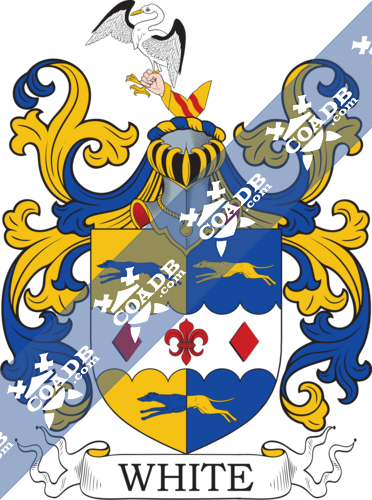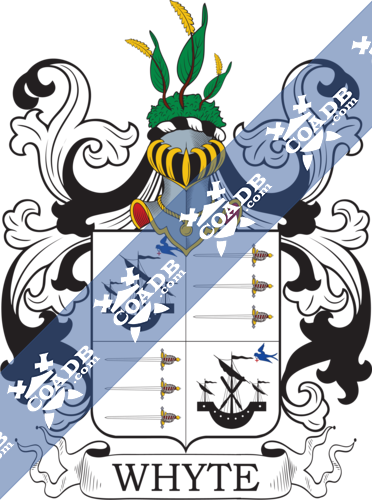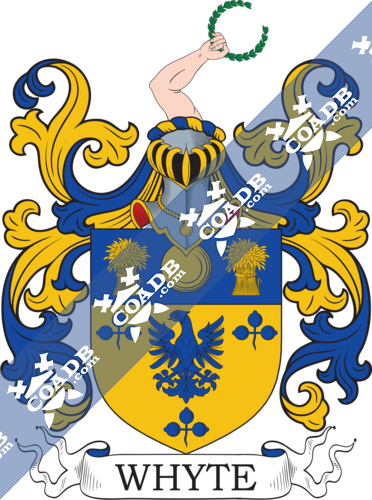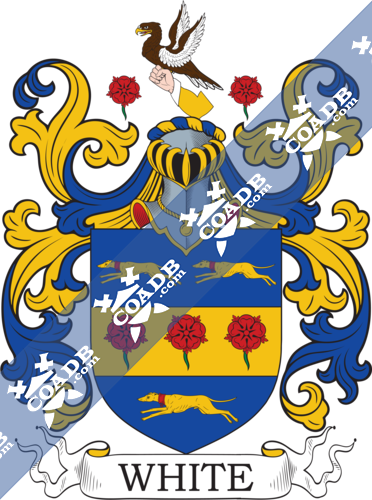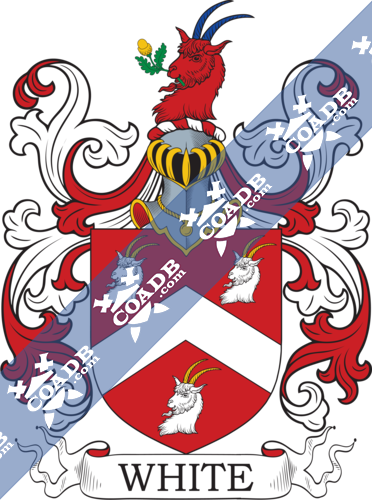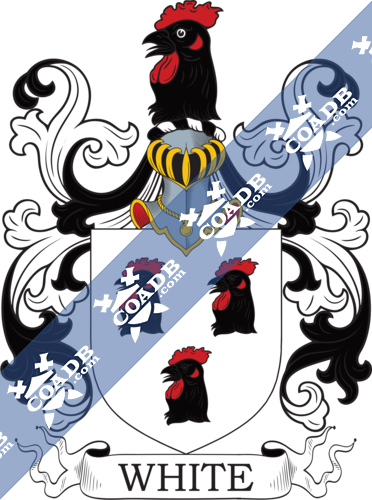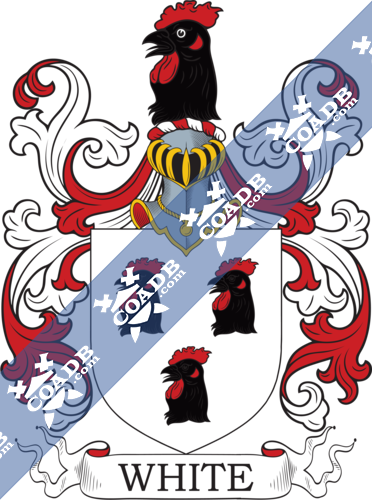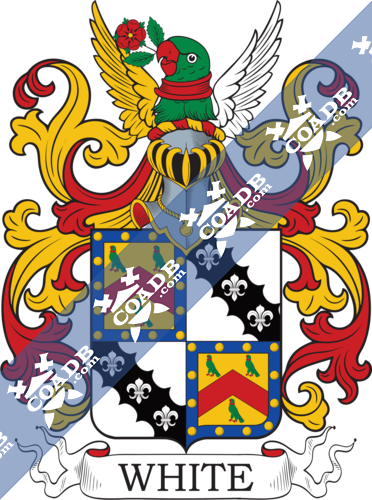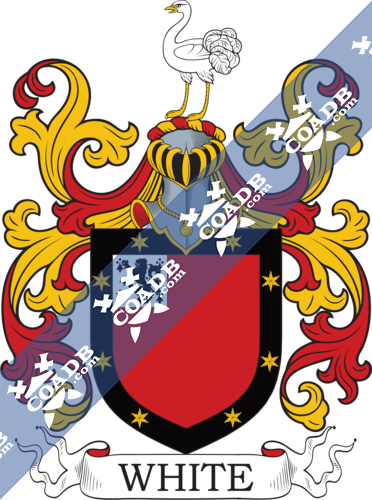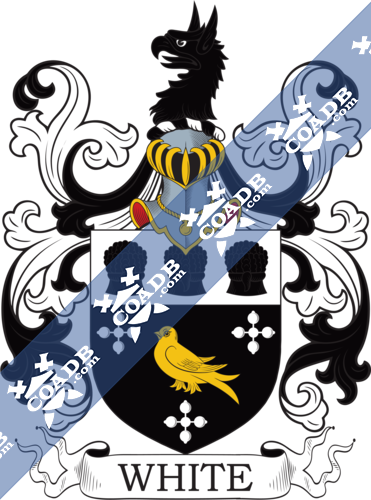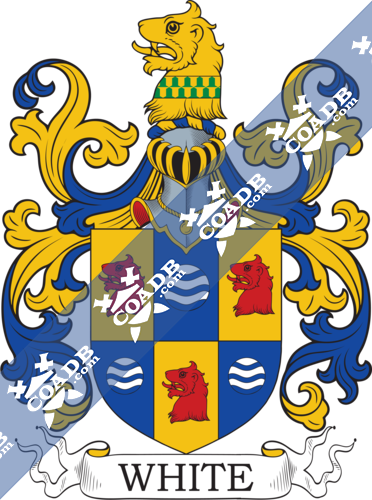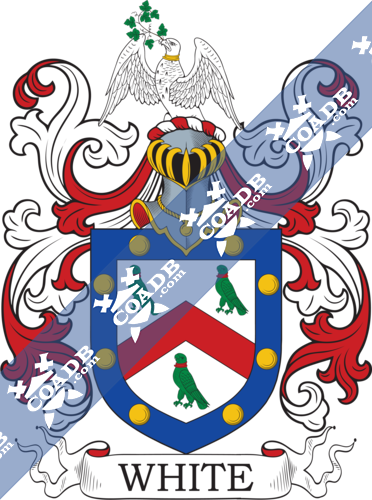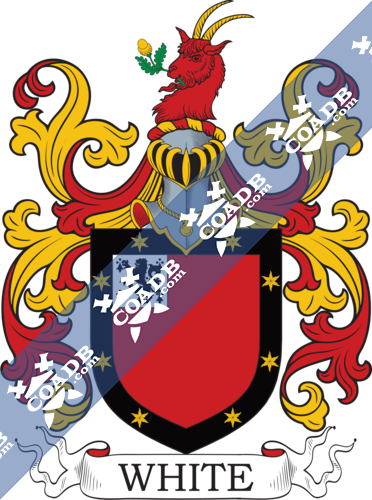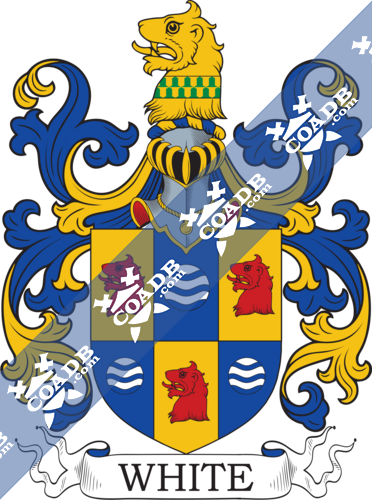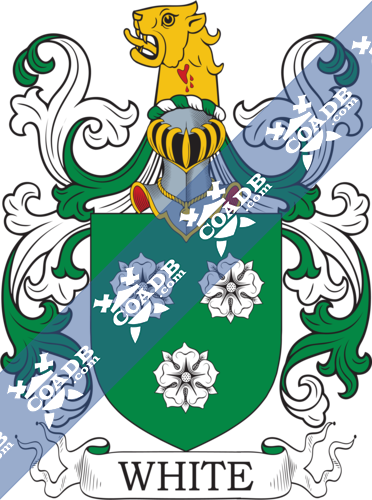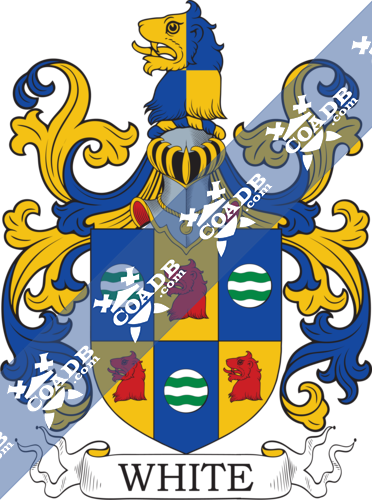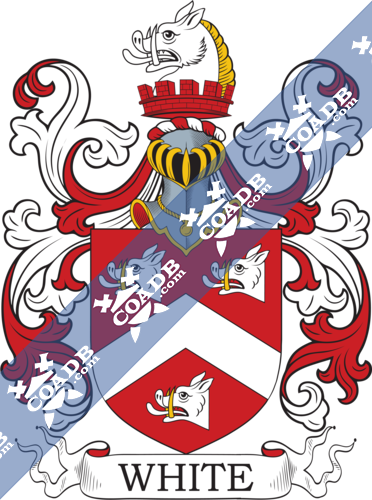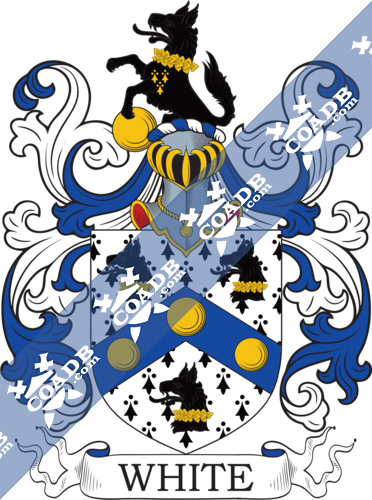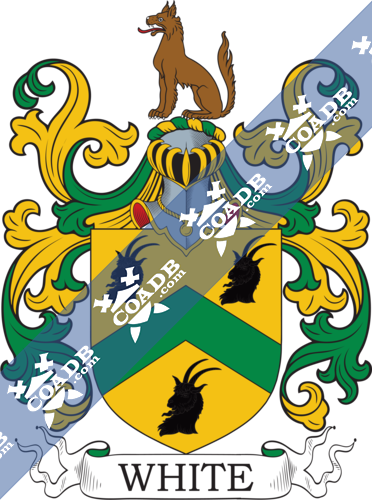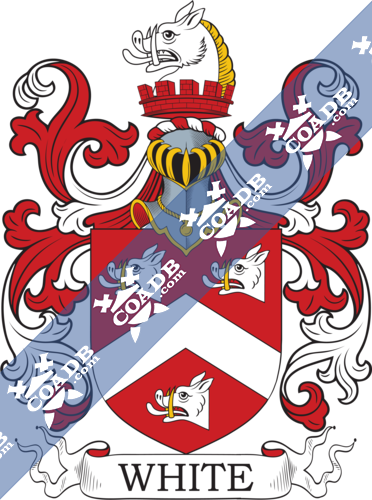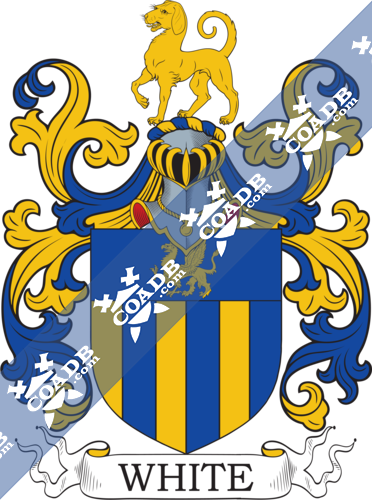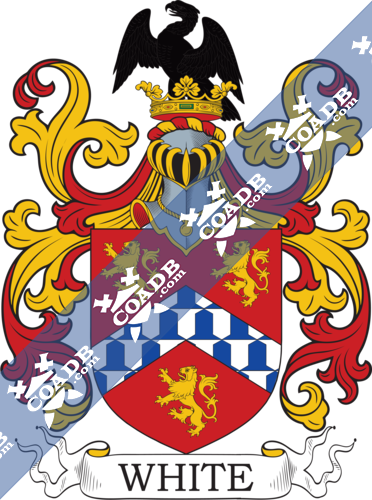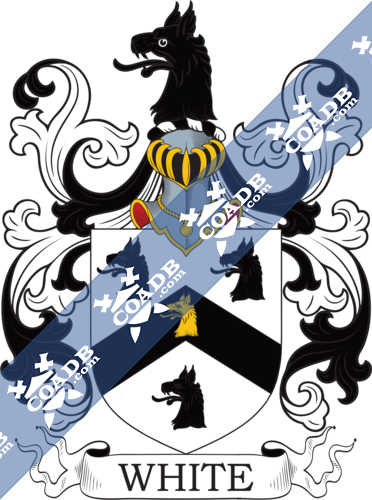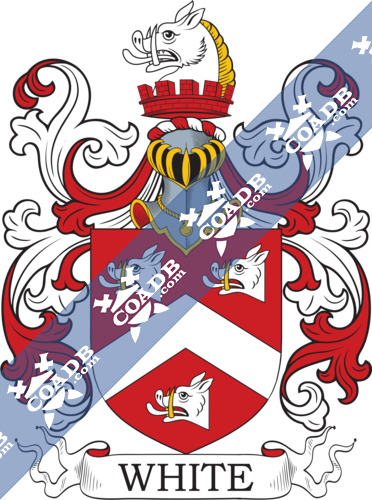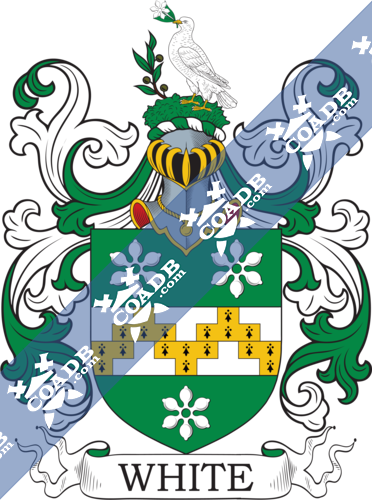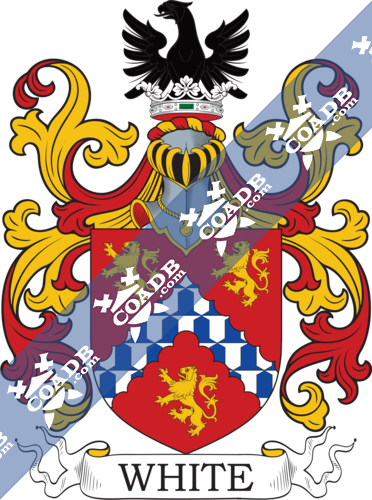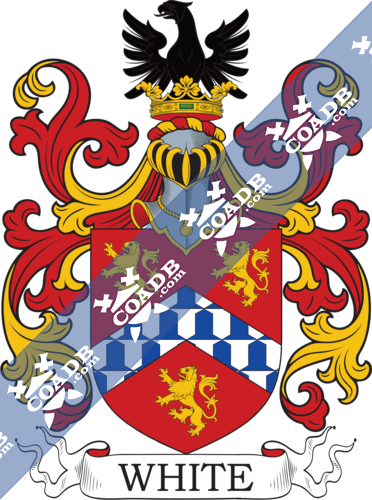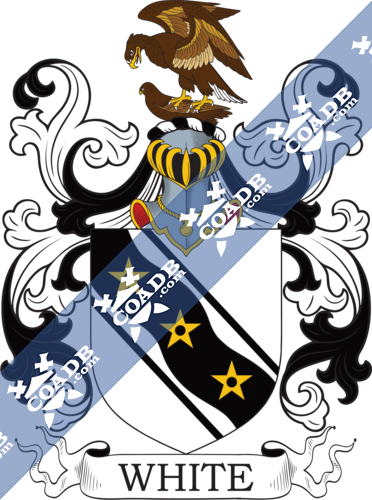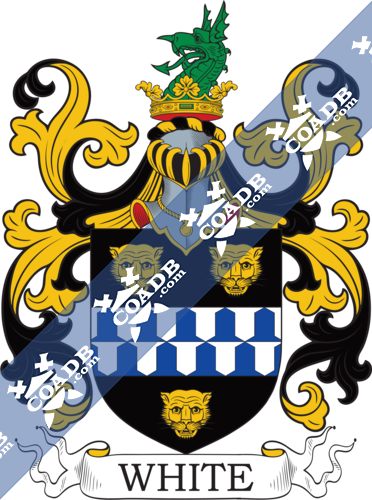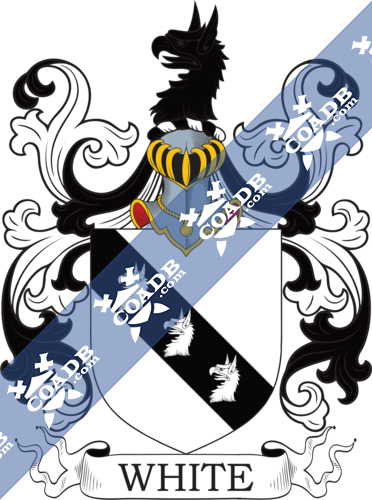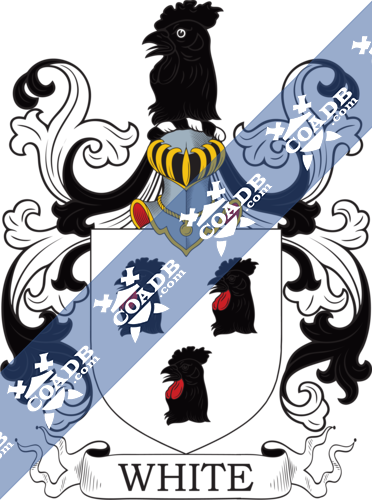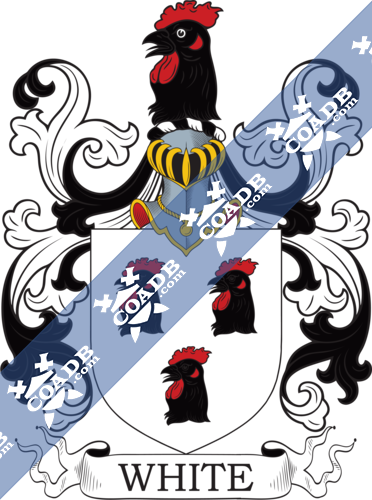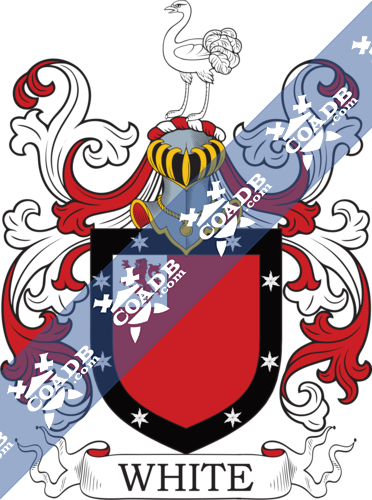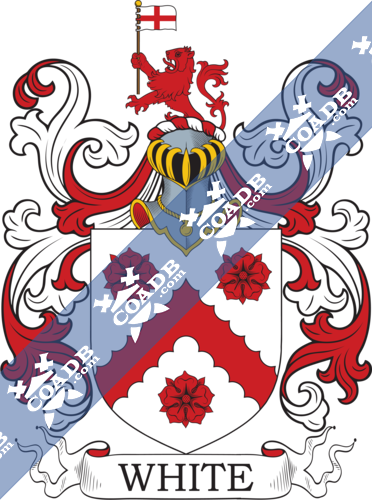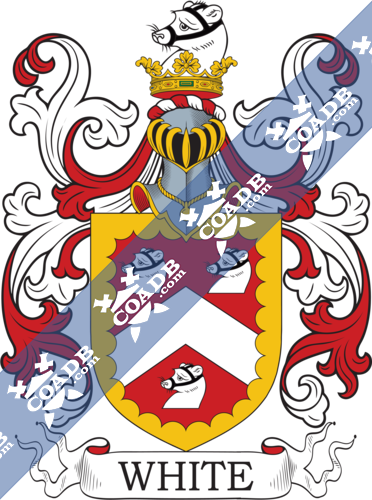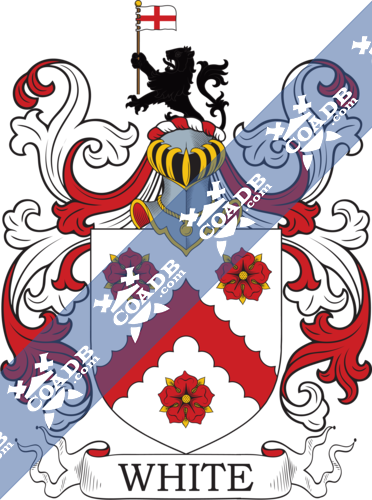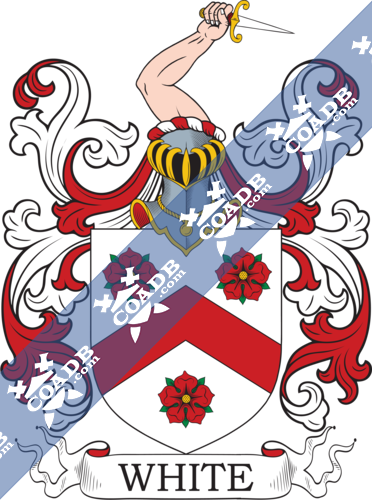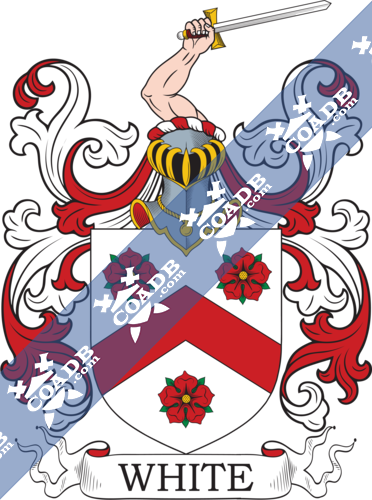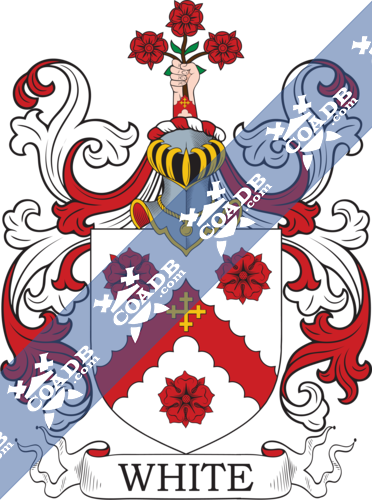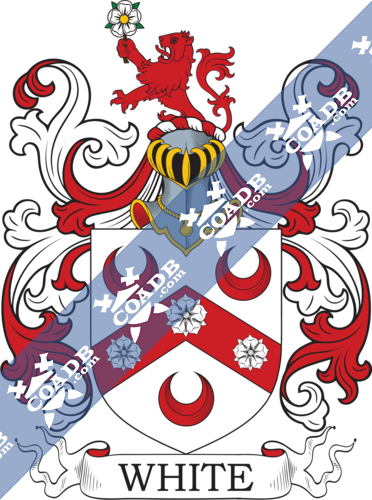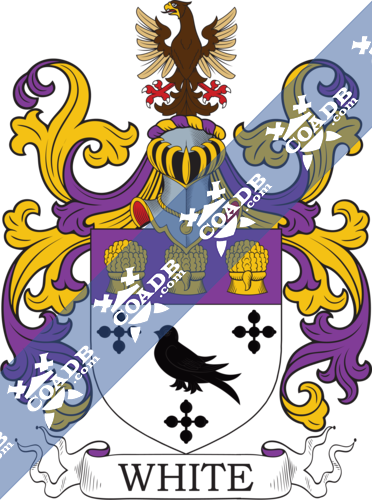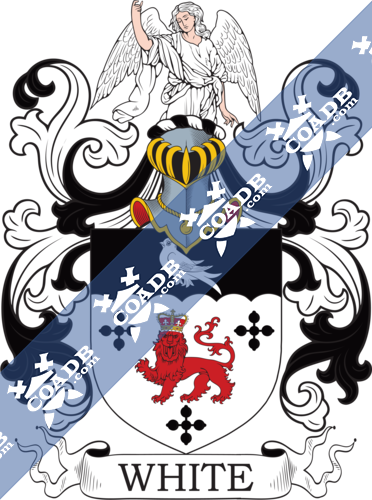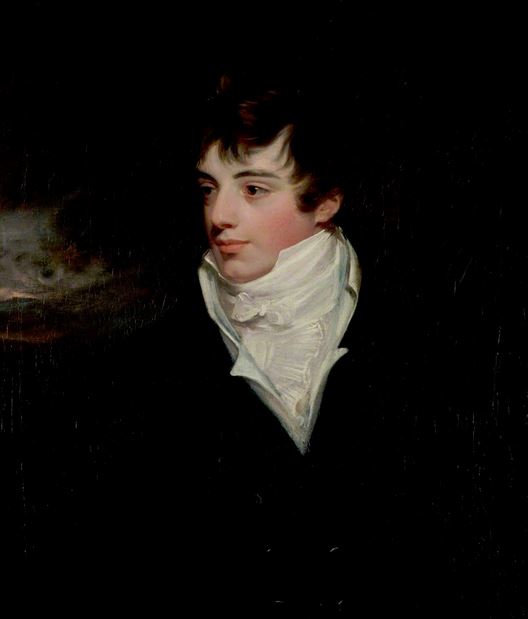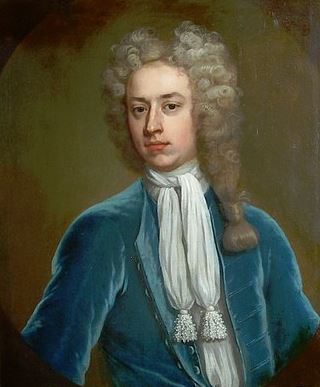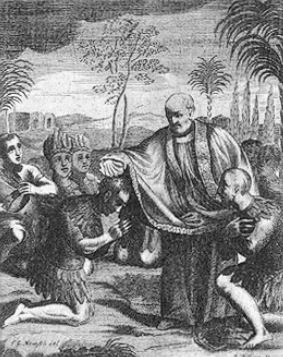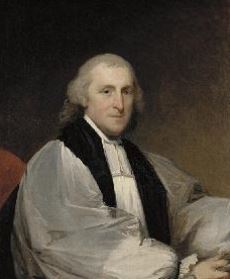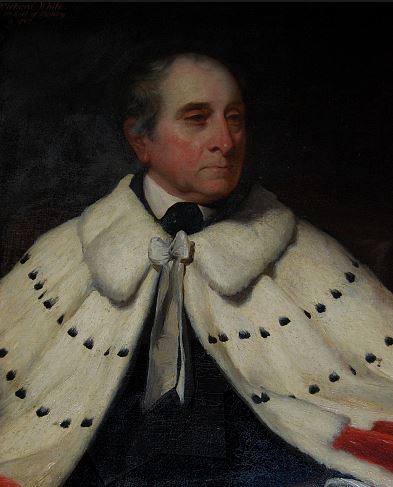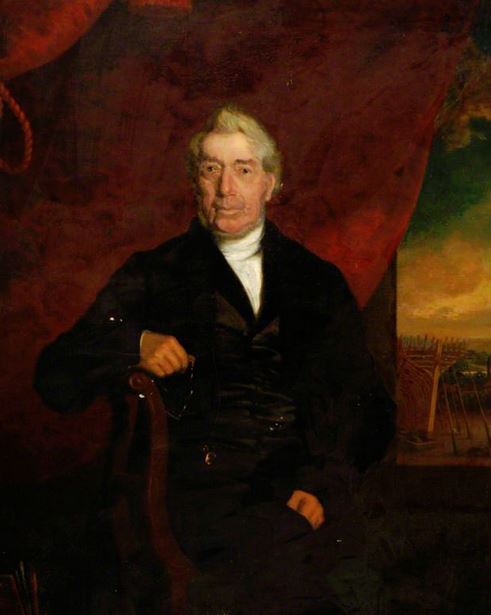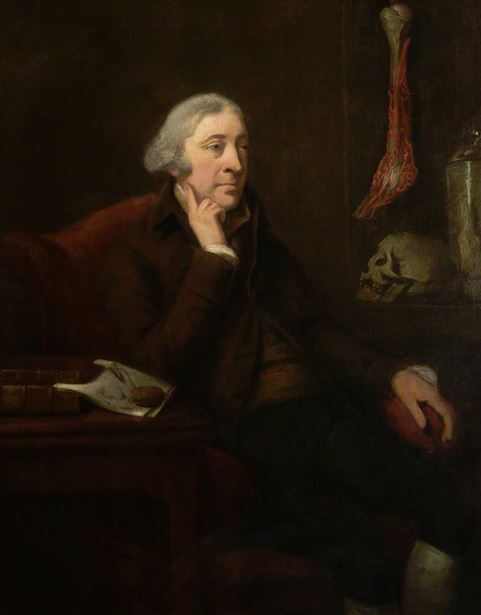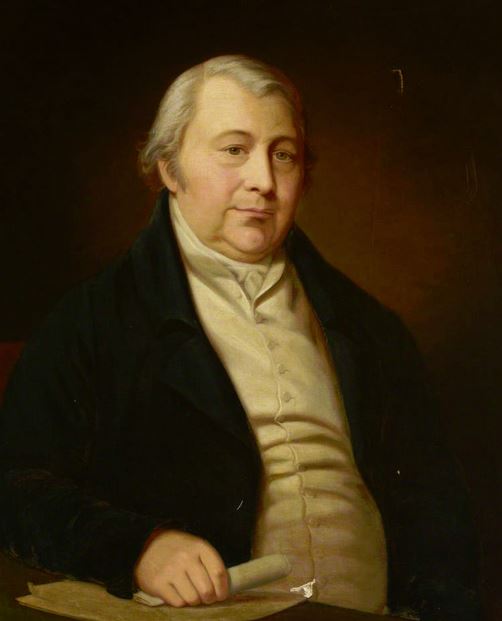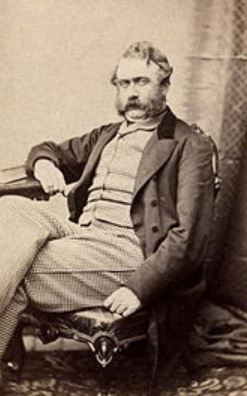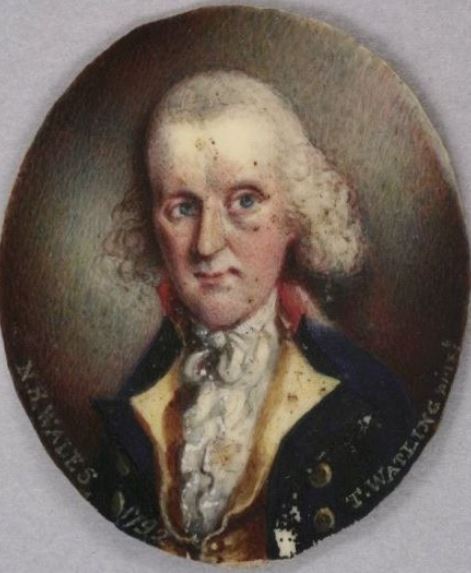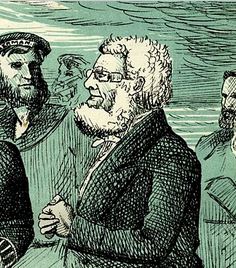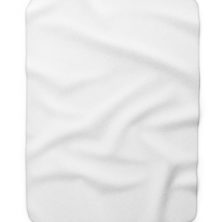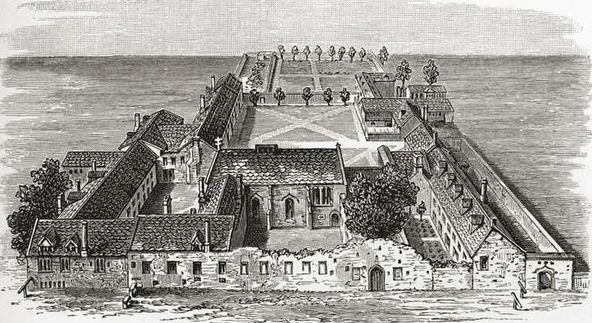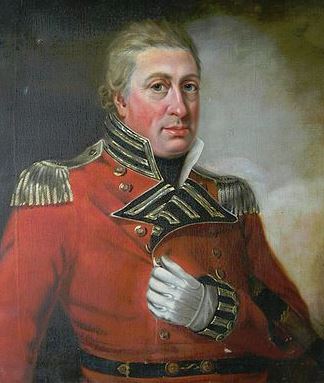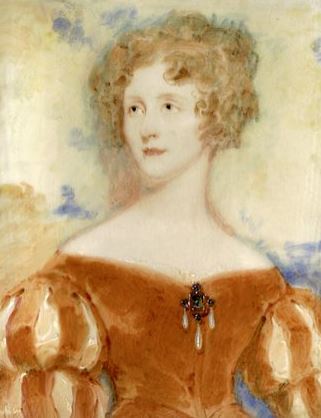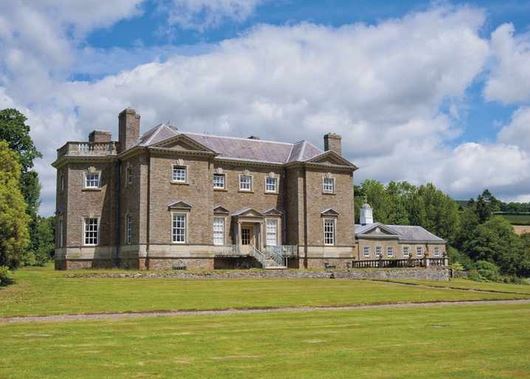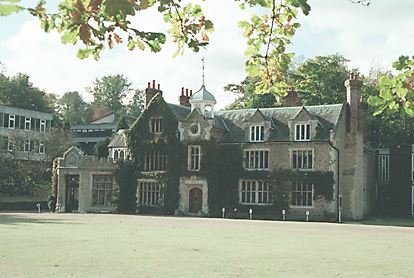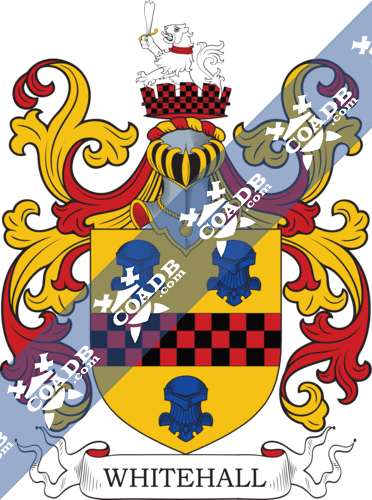White Family Crest, Coat of Arms and Name History
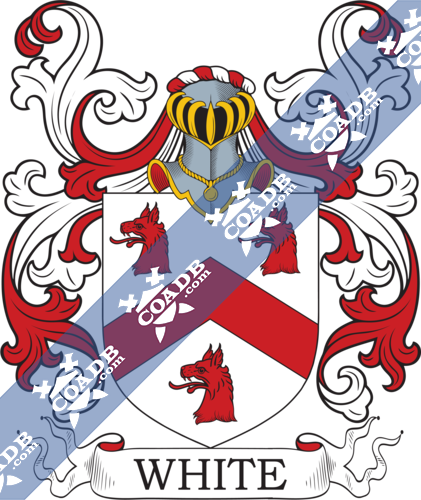
White Coat of Arms Gallery
Don’t know which Coat of Arms is yours?
We can do a genealogical research. Find out the exact history of your family!
Learn MoreSurname Meaning, Origin, and Etymology:
The origin of the surname White has a very particular feature that makes it stand out from other common last names – it doesn’t have just one origin. There are actually four lines that have given life to this popular family name, two of them from England, one from Scotland, and another from Ireland. Because of this, it is necessary to go over the four branches to have all the proper information regarding this surname.
One of the English lines of the White surname can be found for the first time in Gloucestershire when they had the rank of Lords of the Manor, prior to the Battle of Hastings in 1066, after which the impact of the Saxon culture in English history decreased. After the Norman Conquest, the Norman culture ruled over these lands. However, in courts, they still used French. Despite all of this, the Saxon culture didn’t disappear and some of their last names could still be found, which is why there was a Roger Wicht who was the owner of some lands in England during 1176. Wicht was one of the many spelling variations of White.
Also in England, another appearance of this surname took place in South Warnborough, where there is an old story that claimed that there was a Sir Thomas White who used to have breakfast with Queen Elizabeth. Sir Thomas even had a monument in his honor in the church of this location, according to this tale.
There was a different group of people from England with this surname who settled in Ireland after the Anglo-Normand invasion during the 12th century. Because of the mix of languages that was very common in Europe during this time, many words from other languages were incorporated into the names of families. Due to this, we can find the Gaelic name “Bán,” which can be translated into English as “White.” The first bearer of this surname that arrived in Ireland during the invasion was Walter Whyte, and also the first of that family to settle in the counties of Down and Sligo or “Sligeach,” which were located in the Connacht province of Ireland. Then, the name had new spelling variations such as MacWhite.
Another origin of the White surname comes from Scotland. People from this country originally had a single name, but after a time, it became very difficult to distinguish one person from another, so they started to use last names. At the beginning of this phenomenon, the surnames derived from nicknames that were most of the time granted based on physical features. White is a derivation of the Old English word “hwit” which means “white,” and this surname was used by pale people or for people who had white hair.
Finally, one of the first records of this surname is from the Scottish county of Berwickshire, in a village called Coldingham, where Uuiaett Hwite assisted in a charter of King Edgar between 1097 and 1107. There is an even older record of the English charter in which a Wulfnoo Hwita appears, circa 925. According to this information, this surname existed in these lands prior to the Norman Conquest in 1066 thanks to some of the spelling variations of the surname White.
Due to its many origins, there are other appearances of the White surname or its variations in old records. However, these four origins mentioned above are the most important and are those that can be found in reliable sources.
Coat of Arms
Thanks to the fact that there are many different branches of the White surname, there are a lot of coat of arms from the different family groups. One of the most important is the one from the Irish White family, which has a very special meaning. Said coat of arms is made of five principal elements, and each of them symbolize something different. The first element is the argent, which can be white or silver and symbolizes peace and sincerity. Then there is the gules, which is the color of the Martyrs and denotes the power of the military, and the chevron, which represents protection and is granted to everyone who has achieved something important. The engrailed line of the coat of arms represents earth or land. And finally, it has a red rose, which represents beauty and grace.
Spelling Variations
Old surnames usually have some spelling variations, and in the case of the White surname there are a lot of variations due to its multiple origins. This fact, added to the usual reasons why surnames tend to change over time – such as the fusion of languages in the past and the fact that not all societies had a written language, which caused people to write the words as they were pronounced and resulted in a lot of different spellings – is the reason why there were variations of White like Whyte, Wight, Whight, Weight, Whites, Whitte, Whytte, Wighte and others that are more unusual such as MacWhite.
Popularity & Geographic Distribution
White is one of the most popular surnames in the word, which is why it holds the 470th position in the rank of the most common surnames in the world. It is used by approximately 1,064,696 people. The country in which it is more prevalent is the United States and it has the highest density in the island of Montserrat. The second country in which it is used the most after the US is one of the countries where it hails from – England – while Canada is in third place. All of this data is taken from the census done in 2014.
Early Bearers of the Surname
Other appearances of people with the White surname – or its variations – in old records include Ordgar se Wite of Somerset in 1070, Walter le Wytte of London in 1284, and William le Wytte, who appeared in the Subsidy Rolls of York in 1327. There was another appearance of this surname in England during the reign of King Edward II in the Ancient and Feudal Arms of England by the name of Sir John White or Whyght, who fought at the Battle of Boroughbridge against the Sottish in Yorkshire, 1322. In 1086, William the Conqueror ordered the creation of the Domesday Book for Hampshire in England to register land owners; in this record, there was a person named Alwin Wit. Finally, there was William White, who was on board the Mayflower in 1620 and then appeared in the records of a cemetery in Elizabeth City, Virginia in 1624.
History, Genealogy, and Ancestry
The White surname has four important branches in history, which come from three different places and periods. The first ones are the Whites of Durham, which started with George Francis White, who was a Lieutenant Colonel in the army from Old Evet Durham and served during the Sutlej campaign from 1845 until 1846. This line of Whites were established in Durham, and they were part of the Whites of Redheugh, where they held an influential position. They lived in this place until Robert White sold the property in 1620 after a long line of marriages with members of other important families from the region. There was another member of this family who served in the army called Henry White, Esquire, who was from Dedham, Essex. He was an officer in the army and the son of Henry White – also an Esquire of Dedham – who died in 1769. Henry White Jr. had the following sons: Frederic White, who was born on January 18, 1769, and John Henry White who was born on August 26, 1772; they both died young. The third son, Francis George White, was born in 1774 and had two sons of his own: George Francis White (1812-1841) and Henry William White (1814 -1837). The fourth child, Henry White, had his own children and carried on the family name.
The next Henry White was also part of the military, as he was a Major in the army of the 74th regiment. Prior to that, he was part of the Grenadier Guards. His performance during the Peninsular War was outstanding, but he was wounded in battle four times. He had the following sons: Henry Hugh, who became a Lieutenant of the Ceylon Rifle regiment; George Francis, who continued representing the family; Charles, another lieutenant from the 13th regiment born on June 4, 1809, and Frederick John, who was a 1st Lieutenant of the Royal Marines and served during the wars against China and Spain. He also had a son called Augustus Alexander, born on December 1, 1822, who had his own sons: Charles Nevile (b. December 2, 1846), Henry George (b. October 28, 1850), Augustus Alexander (b. October 2, 1850), Arthur Cavendish (b. July 20, 1852), and Herbert Brownlow, who was born on June 14, 1854 and died on August 11 of that same year.
The second branch of Whites are the Whites of Castor, whose head of the family was Frank Armstrong White, Esquire of Castor, Northampton and Lieutenant of Northants and Rutland Militia. He was born on August 10, 1875 and married Fanny Augusta, elder daughter of W. Patterson, Esquire. They had a daughter named Margherita Emily Louisa. This line of the family comes from the Whites of Tuxford, whose important members include Rev. Stephen White, who was the 3rd son of Taylor White. The successor of this line was William Archibald Armstrong, brother of Francis Sellon. Francis Sellon had a son, Henry Ellis, who became part of the 5th Dragoon Guards and had a son named Francis.
William Archibald Armstrong White (b. May 26, 1776) was a Barrister-at-Law. He got married on July 26, 1830 to Sarah, the only daughter of Col. Johnson Newman, a Russian Counsellor of Lisbon. William died in December of 1847, but not before having the following children: Stephen Prescott, who succeeded his father, and Francis, who was born in 1803 and became a reverend. Another of his sons, William Spranger, was born in December of 1809 and also became a reverend. His youngest son, Charles Best, was born in October of 1812 and married Aglae Joséphine, the daughter of a French Admiral; they did not have children. Following this line, there was Stephen Prescott White, Esquire of Castor, born in October of 1801, who was a Member of Lincoln’s Inn and a Barrister-at-Law. He left his estate to his nephew Frank Armstrong White, Esquire of Castor.
The leader of the Whites of Wateringbury – the third branch of the family – was Thomas White, Esquire of Wateringbury Hall and Congelow in Kent. Thomas was born in 1812 and got married on December 3, 1842 to Louisa Frances, the youngest daughter of William Winton, Esquire of Woodgate House. They had only one child, Thomas Archibald Staines, who was born on September 1, 1843 and became a reverend. He got married in 1874 to Mathilda Maximiliana, Baroness von Sentter Loetzen, who was from the South of Germany.
Thomas White was the son of Samuel White, Esquire of Yalding and married Anne Starnes, daughter of James Starness, Esquire of Congelow. He died in 1837.
The final branch of the White surname was the Whites of Grougar. John White, Esquire of Grougar was born in 1810 and married Amelia Susannah (widow of R.A. Grooman, Esquire of Nevhille House) in Twickenham, Middlesex in 1868. This John White was the first son of John White, Esquire of Shawfield and Jessie Orr, daughter of Rober Orr.
Early American and New World Settlers
As has happened with many other last names, White was brought to America thanks to all the bearers of that surname that traveled to the New World. They did so over the centuries, and this includes William White and his wife Susannah, who reached Plymouth in 1620. This couple has an interesting story – their son, who was born in Cape Cod Harbour on board the Mayflower in 1620, was the first child of English people to be born in New England. Then in 1634, Anthony White also got to New England at the age of 27. The next year, in 1635, William White, Charles White, and Ellin White arrived in Virginia.
The migration continued during the 18th century with George White and Abigail White; both reached North Carolina in 1701. Then in 1703, Adam White got to Virginia, while Dennis White arrived in Virginia in 1714, and years later, in 1738, Ellinor White reached Barbados.
During the 19th century, more Whites traveled to the United States, such as Alice White, Catherine White, and Eleanor White; the three of them arrived in New York in 1804. Then in 1811, Donald White got to North Carolina, and Archibald White landed in Maine in 1812.
Another country that also received bearers of the White surname was Canada. Among those immigrants, we can find Peter White, who reached Witless Bay, Newfoundland in 1676. Then, in the 18th century, Arthur White reached Ferryland, Newfoundland. In 1750, Ann White and Elizabeth White arrived in Nova Scotia. Later, in 1774, Mary White also reached Nova Scotia. Mr. Amos White U.E. reached Bell Vue, New Brunswick in 1783. The initials U.E. in his name stood for United Empire, which meant that he was from the United States but was loyal to England during the American Revolution.
This migration to Canada didn’t decrease during the 19th century; thus, there was Margaret White, who arrived in Quebec in 1829, and Elijah D White, who landed in Canada in 1831. Then, in 1833, Michael White, Catherine White, and Ellen White reached Saint John, New Brunswick.
Mottoes
The White surname has another peculiar feature since its origin relies on so many different branches. Said feature is that it has many mottoes since every one of its branches has come up with one of their own. The following are the most important mottoes of the White families:
- “Beware in time”.
- “De Dieu est tout” which can be translated to English as “From God everything.”
- “Fortiter et feliciter” which means “Boldly and fortunately.”
- “Loyal until death.”
- “Obsequens non servilis” which means “courteous not servile.”
- “Omnia mundane turbida” in English means “all things from earth are troublous.”
- “Persevera” which means “persevere.”
- “Plus vigila” in English “watch more.”
- “Sis Justus, et ne timeas” which can be translated to English as “be just and fear not.” This motto is taken from a Shakespeare text.
- “Stat fortuna domus” which means “the fortune of the house remains.”
- “The noblest motive is the public good.” From Bantry White.
- “Vi et virtute” in English means “by strength and valour.”
- “Vincit qui curat” which means “he conquers who is cautious.”
- “Virts omnia vincit” or “virtue conquers all things.”
- “Virtute parta” which translated is “acquired by virtue.”
- “Ever watchful.”
- “Par valeur,” meaning “by valour.”
- “Pur sans peur” which means “purse without fear.”
Mottoes were used in the past by families to express many aspects of themselves, such as their code of conduct, their most important values, or their view on life. They also served the purpose of distinguishing one family from another or as a sort of presentation card. In some cases, mottoes were of such importance to a family that they were included in their coat of arms.
Grantees
Among the most important grantees of the White family, there is John White from London, who was the chiefest governor of Virginia. There was also a John White of Tuxford, a John White of Dorchester, and Mary White. Other grantees were Thomas White of Peterborough, and Walter White, who was the High Sheriff of Exeter and Son of Richard Newton. James White of Exeter, brother of Walter White, was another grantee.
Notables
There are many bearers of the White surname that have stood out in their respective fields. Arts, sports, literature, politics, and science – you will find notable Whites in all of them. Some its notable bearers include Aaron White, (b. 1992) who is an American basketball player; Adam White (1817-1879), who was a Zoologist from Scotland, and Alan White (b. 1972), who is a drummer that has played with the English band Oasis. Another musician that had this surname was the American soul and disco singer Barry White (1944-2003). There is also Brett White, the chief executive of the CBRE group, an important investment firm. Moreover, there is Dana White who is an MMA promoter and president of the UFC. In politics, there was a John White (1802-1845), who was Speaker of the United States House of Representatives, and another John White (1811-1897) who was part of the Liberal Party of Canada. Other notable people with the White surname include Peter White, who was a presenter on BBC Radio Solent and BBC Radio 4, and Patrick White (1912-1990), who was an author from Australia. Finally, Pat White, born in 1986, is an American football quarterback and multisport athlete.
Blazons & Genealogy Notes
1) (Holcott, co. Bedford). Ar. a chev. betw. three wolves’ heads erased gu.
2) (Fyfield, co. Berks). Gu. on a border sa. eight estoiles or, on a canton erm. a lion ramp, of the second. Crest—An ostrich ar. beaked and legged or.
3) (Denham, co. Buckingham, a.d. 1593). Vert three roses ar. Crest—A lion’s head couped or, vulned in the neck gu.
4) (Bridgcourt, Isle of Ely, co. Cambridge). Paly of six or and az. on a chief of the second a griffin pass. of the first. Crest—A talbot pass. or.
5) (co. Chester). Ar. a griffin segreant sa.
6) (St. Stephen’s, co. Cornwall; Oliver White, of St. Stephen’s, temp. James I., son of Oliver White, of same place. Visit. Cornwall, 1620). Ar. on a bend sa. Three griffins’ heads erased of the first. Crest—A griffin’s head erased sa.
7) (Truro, co. Cornwall). Ar. a chev. vert betw. three goats’ heads erased sa. Crest—An ermine sejant ppr.
8) (St. German’s and Ince, co. Cornwall). Or, a chev. vert betw. three goats’ heads erased sa.
9) (Duffield, co. Derby; established there about 1600 by William White, son of John White, of Beere, co. Dorset; his son, AV’illiam White, Esq., of Duffield, m. a co-heir of Talbot, of co. York). Gu. a chev. betw. three goats’ heads erased ar. Crest—An ermine ppr. Another Crest—A goat’s head gu. attired or, holding in the mouth an oak branch vert, fructed gold.
10) (Exeter, co. Devon; granted 24 March, 1541). Ar. on a bend wavy betw. two plain cotises sa. three mullets pierced or. Crest—An eagle preying on a pheasant all ppr.
11) (Poole and Tickleford, co. Dorset; granted 12 June, 1559). Per pale or and az. on a fess engr. ar. betw. three greyhounds courant counterchanged a fleur-de-lis enclosed by two lozenges gu. Crest—An arm embowed, habited or, charged with two bends wavy gu. holding in the hand a stork by the legs, wings expanded ppr. beaked and legged gold.
12) (Charlton House, co. Dorset; descended from Thomas White, merchant, of Poole, co. Dorset, M.P. for that borough, living 1533. The family estateswere acquired by the marriage of Capt. Samuel White with Edith, heir of John Watson, Esq., of Charlton; their great-great-great-grandson, Samuel White, Esq., of Charlton, d. s. p. 1822, and was s. by his nephew, Samuel White-Driver, Esq., of Charlton, son of his sister Anne, m. William Driver, Esq., who thereupon assumed by royal licence, 1835, the surname and arms of White). Az. on a fess betw. three greyhounds courant or, collared gu. as many roses of the last, slipped ppr. Crest—A dexter arm embowed couped above the elbow, vested or, cuffed ar. the hand holding by the legs an eagle volant ppr. beaked gold, betw. two roses slipped, as in the arms. Motto—Virtus omnia vincit.
13) (Weymouth, co. Dorset). Az. three crosses crosslet in bend or. Crest—On a mount vert a curlew close ar.
14) (co. Dorset). Gu. a chev. betw. three goats’ heads couped ar. attired or. Crest—A goat’s head gu. attired az. holding in the mouth an acorn or, leaved vert.
15) (Hedheugh and Old Elvet, co. Durham). Ar. Three cocks’ heads erased sa. combed and wattled gu., quartering; Hanna, Stuart, Adams, Mulcaster, ic. Crest—A cock’s head erased sa. combed and wattled gu. Motto—Vigilaus et audax.
16) (Tunstall Lodge, co. Durham Andrew White, Esq., first Mayor of the borough of Sunderland, 1836, and afterwards M.P. for the same place, was son of John White, shipowner and merchant, and grandson of John White, of Stamfordham, co. Northumberland). Ar. three cocks’ heads erased sa. combed and wattled gu. Crest—A cock’s head as in the arms. Motto—The noblest motive is the public good.
17) (Francis White, Bishop of Ely, 1628, of Caius Coll., son of John White, Parson of St. Neot’s, co. Huntingdon. He was consecrated Bishop of Carlisle 1626, translated to Norwich 1629, translated to Ely 1631, d. 1638). (Chaplain to James I., brother to the Bishop of Ely, d. 1615, buried at St. Mary Woolnoth, London). Gu. a chev. betw. three boars’ heads couped ar. a border engr. of the last.
18) (Clement’s Hall, co. Essex). Quarterly, 1st and 4th, or, a chev. gu. betw. three popinjays vert, beaked, legged, and collared of the second, a border az. bezantee, for White ; 2nd and 3rd, ar. on a bend engr. sa. three fleurs-de-lis of the field, for Holt. Crest—A popinjay’s head vert, collared and beaked gu. betw. two wings, the dexter or, the sinister ar. holding in the beak a rose branch ppr. Motto—Plus vigila.
19) (Hutton, co. Essex; six descents are given in Visit. Essex, 1634). Ar. a chev. gu. betw. three popinjays vert, beaked, legged, and collared of the second, on a border az. eight bezants. Crest—Betw. two wings ar. a popinjay’s head vert, collared gu. holding in the beak a red rose slipped and leaved ppr.
20) (Sutton, co. Essex). Sa. a martlet or, betw. three quatrefoils ar. on a chief of the last three garbs of the field. Crest—A griffin’s head erased sa.
21) (Mickleton, co. Gloucester). Per fess or and az. a pale counterchanged, three lions’ heads erased gu. two and one, as many fountains, one and two. Crest—A lion’s head erased or, collared vaire gold and vert.
22) (Bristol, co. Gloucester). Gu. a chev. engr. betw. three roses ar.
23) (South Wainborough, co. Hants, and of Okingham). Ar. a chev. gu. betw. three popinjays vert, collared of the second, on a border az. eight bezants. Cest—A demi hawk, wings expanded ar. collared or, holding in the beak a slip of a vine ppr.
24) (Southwike, co. Hants). Az. on a cross quarterly erm. and or, betw. four falcons ar. belled of the third, a fret within as many lozenges of the field.
25) (co. Hants). Gu. on a canton ar. a lion pass. sa. crowned or, on a border of the third eight estoiles of the fourth. Crest—An ostrich ar. beaked and legged or.
26) (co. Hants). Gu. on a border sa. eight estoiles or, on a canton erm. a lion ramp, of the second. Crest—An ostrich ar. beaked and legged or. Crest—A goat’s head gu. Attired or, holding in the mouth an acorn gold, leaved vert.
27) (London, from Mickleton, co. Gloucester). Per fess or and az. a pale counterchanged, three lions’ heads erased gu. two and one, and as many fountains, one and two. Crest: A lion’s head erased or, collared vaire; gold and vert.
28) (Whitefriars, near St. Dunstan’s, Farringdon Ward, London, 1624). Sa. a chev. betw. three bucks’ heads cabossed or.
29) (Sir John White, Lord Mayor of London, 1489, founder of St. John’s Coll., Oxford, and Gloucester Hall). Sa. on a cher. betw. three ewers ar. as many martlets gu.
30) (Lord Mayor of London, 1553). Gu. an annulet in chief or, on a canton erm. a lion ramp. sa. on a border of the third eight estoiles of the first.
31) (Lord Mayor of London, 1563). Per fess az. and or, a pale counterchanged, three plates, two and one, each charged with two bars wavy vert, and as many lions’ heads erased, one and two gu. Crest—A lion’s head erased quarterly or and az.
32) (Sir John White, Knt., Lord Mayor of London, 1753. Visit. London, 1568). Per fess az. and or, a pale counterchanged gu. three fountains and as many lions’ heads erased gu. Crest—A lion’s head erased quarterly az. and or, guttee counterchanged.
33) (The Middle Temple, London). Sa. a chev. betw. three bucks’ heads cabossed or.
34) (London, 1634). Gu. a chev. betw. three boars’ heads couped ar. armed or. Crest—Out of a mural coronet gu. a boar’s head ar. crined or.
35) (John White, of Lime Street, London). Erm. on a chev. az. betw. three wolves’ heads erased sa. each gorged with a wreath of vine leaves or, as many bezants. Crest—A demi wolf sa. gorged with a wreath of vine leaves, charged on the shoulder with three erm. spots, two and one or, the sinister forepaw resting on a bezant.
36) (London). Gu. a border sa. entoyre of mullets or, on a canton erm. a lion ramp. sa. an annulet for diff.
37) (London). Or, a chev. vert betw. three goats’ heads erased sa. Crest—A wolf sejant ppr.
38) (Hackney, co Middlesex). Gu. a chev. betw. three boars’ heads couped ar. tusked or. Crest—Out of a mural coronet gu. a boar’s bead ar. bristled or.
39) (Islington, co. Middlesex). Per chev. embattled or and gu. three roses counterchanged, slipped ppr. on a chief of the second as many hour-glasses of the first.
40) (Mapis, co. Middlesex, formerly of Benal Abbey, Griesby, co. Notts). Gu. a chcv. vair betw. three lions ramp. or. Crest—Out of a ducal coronet or, a demi eagle, wings expanded sa. Motto—Loyal unto death.
41) (Newton Flatman, co. Norfiik). Ar. on a chev. betw. three wolves’ heads erased sa. a wolf’s head or. Crest—A wolf’s head erased sa.
42) (co. Norfolk). Gu. a chev. betw. three boars’ heads couped ar. tusked or. Crest—Out of a mural coronet gu. a boar’s head ar. bristled or.
43) (co. Norfolk). Gu. a chev. engr. betw. three boars’ heads couped ar. a border engr. of the last.
44) (Castor, co. Northampton; branch of White, of Wallingwell). Gu. a chev. vair betw. three lions ramp. or. Crest—Out of a ducal coronet or, a demi eagle, wings expanded sa. Motto—Loyal unto death.
45) (Hursley, co. Northampton; granted 1750). Vert a fess cuppa ar. and erminois betw. three narcissus flowers of the second. Crest—An olive branch issuing out of a mount, thereon a dove holding in the beak a narcissus flower slipped and leaved all ppr.
46) (Heleside, co. Northumberland). Ar. three cocks’ heads erased sa. combed and wattled gu. Crest—A cock’s head erased sa. combed and wattled gu.
47) (Tuxford, co. Nottingham; Sir John White, Knt., of Tuxford, temp. James I., son of Thomas White, of Woodhead, co. Rutland, and grandson of Nicholas White, co. Suffolk. Visit. Notts, 1614). Gu.a chev. engr. vair betw. three lions ramp. or. Crest—Out of a ducal coronet ar. a demi eagle displ. sa.
48) (Wallingwells, co. Nottingham, bart. The name Johannes White, of Colynghame,” appears in a list of the gentry of co. Notts, drawn up 12 Henry VI., 1428. And in the list of 1569 his descendant, Thomas White, is described as freeholder of lands in North Collingham. He purchased the manor of Tuxford, co. Notts, and Woodhead, co. Rutland. from Mary I., he received a grant of the manors of Cotgrave, co. Notts, Prestonatone, co. Somerset and Kynwardstone, co. Somerset). Gu. a chev. vair betw. three lions ramp. or. Crest—Out of a ducal coronet or, a demi eagle, wings expanded aa. Motto—Loyal unto death.
49) (Henllan, co. Pembroke). Sa. a chev. betw. three buck’s heads cabossed or.
50) (Thomas White, Bishop of Peterborough, 1685-91; granted 1685). Sa. a dove ar. on a chief of the second three crosses pattee gu.
51) (Linley Hall, Bishop’s Castle, co. Salop). Ar. on a bend wavy betw. two plain cotises sa. three mullets pierced or. Crest—An eagle preying on a falcon all ppr. Motto—Omnia mundana turbida.
52) (Yeovil, co. Somerset; William White in. Nelly, dau. and co-heir of John Mervin, Esq.). Quarterly, 1st and 4th, per pale or and az. on a fess engr. ar. betw. three greyhounds courant counterchanged a fleur-de-lis enclosed by two lozenges gu., for White; 2nd, ar. a demi lion ramp. sa. charged on the shoulder with a fleur-de-lis or, for Mervin; 3rd, ar. on a bend engr. betw. two lions ramp. sa. three annulets or, for Lambert. Crest—An arm embowed, habited or, charged with two bends wavy gu. holding in the hand a stork by the legs, wings expanded ppr. beaked and legged gold.
53) (Pilewell, co. Southampton). Paly of six or and az. on a chief of the second a griffin pass. of the first.
54) (Sacrist of Lichfield Cathedral, co. Stafford). Per chev. embattled or and gu. three roses counterchanged, slipped ppr. on a chief of the second three hour-glasses of the first.
55) (Stoke Nayland, co. Suffolk, extinct; arms impaled with Thorle, Shouldham, St. Low, Tindall, Yelverton, Le Groos, Clipesby, Prisiott, Holditch, Dalton, in the windows of St. Mary’s Shottisham, Lammas Church, and Swennington. A branch settled in Norfolk, and ended in the female line in 1600). Gu. a chev. betw. three boars’ heads couped ar.
56) or Whight – (Ashsted, co. Surrey). Sa. a fess vair betw. three leopards’ faces or. Crest—Out of a ducal coronet or, a dragon’s head vert.
57) (Nordian and Winchilsea, co. Sussex). Paly of six or and az. on a chief of the second a griffin pass. of the first. Crest—A talbot pass. or.
58) (Goodhills, Isle of Wight). Paly of six or and az. on a chief of the second a griffin pass. of the first
59) (Le White) (Bromham, co. Wilts). Az. a fess betw. three garbs or.
60) (John White, Bishop of Winchester, 1557, translated from Lincoln, where he was Bishop from 1554: he preached the funeral sermon of Mary I., deprived by Queen Elizabeth, d. 1560). Per chev. embattled or and gu. three roses counterchanged, slipped vert, on a chief of the second three hour-glasses ar. framed gold.
61) (Puxton, co. Worcester). Ar. three cocks’ heads erased sa. wattled gu. Crest—A cock’s head erased sa.
62) (co. York). Ar. three cocks’ heads erased sa. combed and wattled gu. Crest—A cock’s head erased sa. combed and wattled gu.
63) (borne by John White, Esq., of Doncaster, co. York). Gu. on a canton ar. a lion ramp. of the field, on a border sa. eight estoiles of the second. Crest—An ostrich ar.
64) (granted 1 March, 1467, to William White). Sa. on a chev. erm. betw. three flagons with spouts ar. as many martlets gu.
65) (borne by Admiral Sir John Chambers White, K.C.B.). Vert a naval crown or, betw. three roses ar. barbed and seeded ppr. Cresl—A lion’s head erased ar. gorged with a wreath of laurel vert, therefrom pendent an escutcheon az. charged with a representation of the gold medal presented to that officer by the Grand Signior in commemoration of his services in Egypt in the year 1801, pendent from a riband tennee.
66) Or, a fess chequy ar. and az. betw. three eagles’ heads erased of the last. Crest—A fountain.
67) Ar. a chev. engr. betw. three roses gu. Crest—A demi lion ramp. gu. holding a flag ar. charged with a cross of St. George, staff ppr.
68) Gu. a chev. betw. three bears’ heads couped ar. muzzled sa. a border engr. or. Crest—Out of a ducal or, a bear’s head, as in the arms.
69) Az. on a cross quarterly erm. and or, a fret enclosed by four lozenges gu. betw. as many falcons ar. belled of the third. Crest—Out of a ducal coronet per pale or and gu. a camel’s head az. cared gold, on the neck a wreath red and gold.
70) Az. three bars gemel or, as many lions’ heads erased in chief of the last.
71) Sa. on a chev. erm. betw. three jugs ar. as many martlets of the field.
72) Ar. on a cross engr. betw. four martlets sa. five bezants, a border gobony gu. and or.
73) Per pale sa. and ar. two flaunches and three fleurs-de-lis in fess counterchanged.
74) Gu. a chev. betw. three bears’ heads couped ar. muzzled gu. a border engr. of the second.
75) Gu. on a border sa. eight mullets or, on a canton erm. a lion ramp of the first.
76) Ar. a griffin segreant sa.
77) Ar. a lion salient gu. in chief three mullets sa.
78) Per chev. sa. and ar. three boars’ heads counterchanged, armed or.
79) or Whyte – (Leixlip, co. Kildare; descended from Walter Whyte, who accompanied Richard de Сlare, Earl of Pembroke (Strongbow) at the invasion of Ireland, 1170; Sir Nicholas White, of Leixlip, Grand Seneschal of Wexford, and Governor of the Castle, was Master of the Rolls in Ireland 1572, and was knighted by Sir John Perrott, Lord Deputy of Ireland, 1584; his son, Andrew White, Esq., of Leixlip, d. 31 July, 1599; Fun. Ent. Ulster’s Office, John White, Esq., of Leixlip; his representative, temp. George III. m. 1776, Letitia, dau. of Hon. Thomas Burke, and granddau. of John, ninth Earl of Clanricarde, and had, with other issue, Charles, of Strandfield House, co. Wexford, who was father of Charles John, b. 1804, who hud seven sons, and Nicholas Charles, of Loughhrickland). (Loughbrickland, co. Down ; descended from Nicholas Charles White, fifth son of John White, Esq., of Leixlip). (allowed by Hawkins, Ulster, 1765, to Andrew James White, Knight of the Order of St. Louis, colonel in Dillon’s regiment in France; descended from Robert White, third son of Andrew White, Esq., of Leixlip, temp. Queen Elizabeth). Ar. a chev. engr. betw. three roses gu. barbed and seeded or. Crest (Reg. Ulster’s Office)—A demi lion ramp. sa. holding betw. the paws a flagstaff ppr. flag ar. thereon the cross of St. George gu. Motto—Echel agus coruic.
80) (Corston, co. Dublin; Richard White, Esq., of Corston, eldest son of William White, of same place, who d. 1595, and grandson of William White, also of Corston. Visit, city of Dublin, 1607). (Dublin; Lawrence White, Sheriff city of Dublin, 1584, second son of William White, Esq., of Corston. Visit, city of Dublin, 1607). (Dufferin, co. Down; Fun. Ent. Ulster’s Office, 1624, Nicholas White, Esq., of Dufferin). (Chapelizod, co. Dublin; impalement Fun. Ent. Ulster’s Office, 1620, Mathew Dillon, of Staffordstown, co. Meath, whose wife was Alice, dau. of Rowland White, Esq., of Chapelizod). Ar. a chev. engr. betw. three roses gu. seeded and barbed ppr. on a border az. eight cinquefoils or.
81) (The Ward, co. Dublin; Thomas White, merchant, of the city of Dublin, temp. James I., son of John White, Sheriff of Dublin, temp. Queen Elizabeth. Visit, city of Dublin, 1607). Per pale ar. and gu. a chev. engr. betw. three roses all counterchanged, seeded and barbed ppr.
82) (Richardstown, Queen’s co , and the city of Waterford; arms and pedigree registered by Hawkins, Ulster, 1720, to Thomas White, gent., of the city of Waterford, grandson of Edward White, Esq., of Richardstown, who removed to the city of Dublin). Ar. a chev. betw. three roses gu. seeded and barbed ppr. Crest—A naked arm holding in the hand a dagger all ppr. Motto—Vicimus.
83) (certified by Hawkins, Ulster, 1772, as the arms of Theobald White, who left Ireland, temp. Queen Elizabeth, and had a son, William White, b. in France; a branch of White, co. Waterford). (Cadiz, in Spain; allowed by Hawkins, Ulster, 1777, to Robert White, of Cadiz, eighth in descent from Robert White, Esq., of Kilmurry, co. Clare). Ar. a chev. betw. three roses gu. barbed and seeded ppr. Crest—An arm in armour embowed, holding in the hand a dagger all ppr. Motto—Vicimus.
84) (Benicarloe, in Spain; allowed by Hawkins. Ulster, 1776, to Patrick White, of Benicarloe, grandson of Stephen White, of Quin, co. Clare, whose father, Richard White, was fourth son of Sir Dominick White, Knt., of Limerick, grandson of Sir Dominick White, Knt., temp. Henry VIII.). Same Arms. Crest—A naked arm embowed holding in the hand a sword all ppr. Motto—Ardua per preceps gloria vadit iter.
85) (The Trimmer, co. Wexford; Nicholas White, Esq., of The Trimmer, a.d. 1618, son of Simon White, and grandson of John White, both of same place. Visit. Wexford, 1618). Ar. on a chev. betw. three roses ga. another rose of the first, all seeded and barbed ppr.
86) (Ballyellis, co. Wexford; Reg. Ulster’s Office to John White, Esq., of Ballyellis, d. 1685). (Scarnagh, co. Wexford, afterwards Ballynahinch, co. Wicklow). Gu. a chev. vair betw. three lions ramp. or. Crest—On a mount vert three arrows, two in saltire. points down, and one in fess, point to the dexter gu. beaded or, flighted ar. Motto—Innocent couragious activity. Motto—Sit justus et ne timeas.
87) (White-Jervis) (exemplified to John Jervis White, Esq., of Ballyellis, upon his assuming, by royal licence, 1797, the additional surname of Jervis). Quarterly, 1st and 4th, sa. a chev. erm. betw. three martlets or, for Jervis; 2nd and 3rd, gu. a chev. vair betw. three lions ramp, or, armed and langued az., for White. Crests—1st, Jervis: A martlet or; 2nd, White: Three arrows, two in saltire, points down, the other in fess, point to the dexter gu. headed or, flighted ar. See Jervis, Bart., of Ballyellis.
88) (Hedges-White, Earl of Bantry). Quarterly, 1st, gu. an annulet or, in the chief point a crescent ar. on a border sa. ten estoiles gold, on a canton erm. a lion ramp. of the fourth, for White; 2nd, az. three swans’ heads erased ppr., for Hedges; 3rd, ar. on a chev. sa. three quatrefoils or, for Eyre; 4th, gu. ten bezants, four, three, two, and one, a canton erm., for Zouche. Crests—1st, White (on the centre): A heron close ar. beaked and legged or, charged with a crescent gu.; 2nd, Hedges (on the dexter): A swan’s head erased ppr.; 3rd, Eyre (on the sinister): A leg booted, armed, and spurred, couped at the thigh per pale gu. and ar. spur gold. Supporters—Dexter, a dragoon officer with a drawn cutlass in the right hand all ppr.; sinister, a female figure representing Ireland, habited in a long blue vest, an ancient crown on her head, and in her left hand a spear, and standing in front of a harp all ppr.; military trophies behind the supporters and shield. Motto—The noblest motive is the public good.
89) (Woodlands, co. Dublin, and Rathcline, co. Longford; granted to Henky White, Esq., of those places, Lord Lieutenant of co. Longford, fourth son of Luke White, Esq., of Woodlands, and to his (Luke White’s) descendants). Ar. on a chev. engr. gu. betw. three roses of the last a cross crosslet or. Crest—A cubit arm erect ppr. holding a sprig also ppr. bearing three roses gu. on the arm a chev. engr. of the last, charged with a cross crosslet or. Motto—Viet virtute.
90) (Baron Annaly). Ar. on a chev. engr. gu. betw. three roses of the last a cross crosslet or. Crest—A cubit arm ppr. charged with a chev. engr. gu. thereon a cross crosslet or, in the hand three roses gu. slipped ppr. Supporters—On the dexter side a horse ar. caparisoned with the trappings of the 14th Regiment of Light Dragoons ppr.; and on the sinister side an Irish wolfhound ppr. gorged with an antique crown and chained or. Motto—Vi et virtute.
91) (Fun. Ent. Ulster’s Office, 1622, Francis White, Secretary to Oliver, Viscount Grandison, Lord Deputy of Ireland). Sa. on a chev. betw. three crescents ar. a leopard’s face enclosed with two cinquefoils pierced gu.
92) (Pitchfordstown, co. Kildare; Fun. Ent. Ulster’s Office, 1640, Walter White, Esq., of Pitchfordstown, d. 19 May, and buried in St. John’s Church, Dublin, 21st same month). Gu. a lion pass. guard. ar. betw. three mullets pierced or.
93) (Redhills, co. Cavan; Reg. Ulster’s Office). Ar. on a chev. betw. three crescents gu. as many roses of the field. Crest—A demi lion ramp. gu. holding betw. the paws a white rose, stalked and leaved ppr.
94) (Reg. Ulster’s Office). Ar. a lion ramp. gu. in chief three mullets sa. Crest—A demi lion ramp. ar. semee of pomeis, ducally gorged gu.
95) (Reg. Ulster’s Office). Ar. three decrescents gu.
96) (Milton, Scotland, 1762). Ar. a dexter hand couped fessways, holding a dagger in pale gu. betw. three quatrefoils sa. on a chief az. as many quatrefoils or. Crest—An arm vambraced, darting a spear ppr. Mottoes—Over the crest: Par valeur; below the shield: Providentia et valore.
97) (Janette, Countess Conte, 1770). Ar. a martlet betw. three quatrefoils sa. on a chief purp. three garbs or. Crest—An eagle displ. ppr. membered gu. Motto—Virtute parts.
98) (Edinburgh, and Fens, co. Roxburgh, 1869). Ar. a lion pass. guard. gu. imperialty crowned ppr. betw. three quatrefoils sa. on a chief of the last a martlet of the first. Crest—A demi angel ppr. Motto—Pur sans peur.
99) (Edinburgh, 1869). As the last, with the chief engr. for diff. Same Crest and Motto.
100) (Burntshields, Scotland). Ar. an eagle displ. betw. three quatrefoils sa. on a chief engr. of the second as many quatrefoils of the first. Motto—Labore parta.
101) (Bankhead, co. Lanark, 1786). Ar. a martlet betw. three quatrefoils sa. on a chief gu. as many quatrefoils or. Crest—A martlet sa. Motto—Vincit qui curat.
102) (Markle, Scotland, 1680). Ar. an eagle volant betw. three quatrefoils sa. on a chief of the last as many quatrefoils of the first. Crest—A chevalier on horseback, holding in the right hand a sword fessways ppr. Motto—Vincit qui curat.
103) (Kilbyrne and Nursetown, co. Cork. Confirmed to James Grove White, Esq., Captain Duke of Cambridge’s Own Middlesex Regt. and to the other descendants of John White, Esq., of Kilbume, son of the marriage in Nov. 1694, of James White, Jun., of Dromanagh, in the Barony of Decies, co. Waterford, with Grace, dau. and heir of John Grove, Esq., of Cahirduggan and Kilbume, co. Cork). Quarterly, 1st and 4th, ar. on a chev. gu. betw. three roses of the last barbed vert seeded gold a cross pattee or, for White; 2nd and 3rd, erm. on a chev. engr. gu. three escallops ar., for Grove. Crest—A dexter arm in armour embowed holding in the hand a dagger all ppr. the arm charged with a cross pattee or. Motto—Nonrissez l’esperance.
104) Whyte – Vert three roses ar. Crest—A lion’s head couped gu.
105) Whyte – Ar. a cross moline gu.
106) Whyte – or White (Shottisham, co. Norfolk; represented by D’Oly, of Shottisham). Gu. a chev. betw. three boars’ heads couped ar. a border engr. of the last.
107) Whyte – or White (Fretenham, co. Norfolk, 1435; descended from the above). Same Arms, without the border.
108) Whyte – (Bennochie, co. Fife, 1676; now Whyte-Melville). Ar. a martlet displ. betw. three quatrefoils sa. on a chief of the second as many quatrefoils of the first. Motto—Virtute parta.
109) Whyte – (Conland, Scotland, 1672). Ar. an eagle displ. betw. three quatrefoils sa. on a chief indented of the second as many quatrefoils of the first. Motto—Honeste parta.
110) Whyte – (Stockbriggs, co. Lanark, 1754). Quarterly, 1st and 4th, ar. a lymphad, oars in saltire sa. in the sinister chief a martlet volant with a small chain about its neck az. to which is appended a plain cross gu.; 2nd and 3rd, ar. three broadswords fessways ppr. Crest—An adder issuing out of marshy ground paleways and nowed ppr. Motto: Fortuna favet.
111) Whyte – (Grougar, co. Ayr, and Arddarroch, co. Dumbarton, 1866). Or, an eagle displ. betw. three trefoils az. on a chief of the second a bezant betw. two garbs of the first. Crest—A dexter arm from the shoulder grasping a wreath of laurel ppr. Motto—Virtute.
112) Wight – (Ormiston, co. Haddington: Cathcart Boycott Wight, Esq., was only son of Andrew Wight, Esq., of Ormiston, by Louisa Maria Catherine, youngest dau. and co-heiress of Thomas Boycott, Esq., of Rudge Hall, co. Salop). Gu. a chev. erm. betw. three bears’ heads couped ar. muzzled sa., quartering Boycott. Crest—In a mural coronet gu. a bear’s head ar. muzzled and collared sa. Mottoes—Fortuna vectem sequitur; and, Pro rege et religione.
113) Wight – (Braboeuf Manor, co. Surrey). Gu. a chev. erm. betw. three bears’ heads couped ar. muzzled sa. Crest—Out of a mural crown a bear’s head ar. muzzled sa.
114) Wight – (London). Gu. a chev. erm. betw. three bears’ head’s couped ar. muzzled sa. a border engr. of the last.
115) Wight – (co. Norfolk). Gu. a chev. betw. three boars’ heads couped or. Crest—An acorn or, stalked and leaved vert.
116) Wight – (Scotland). Gu. a chev. betw. three boars’ heads couped ar. Crest—A dexter hand holding a dagger, point downwards ppr. Motto—Fortiter.

